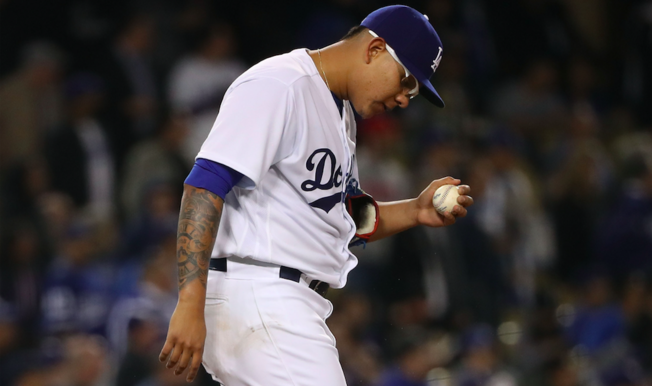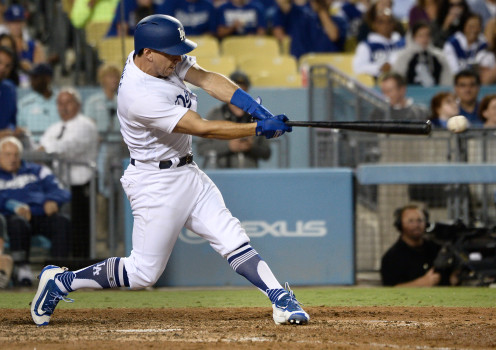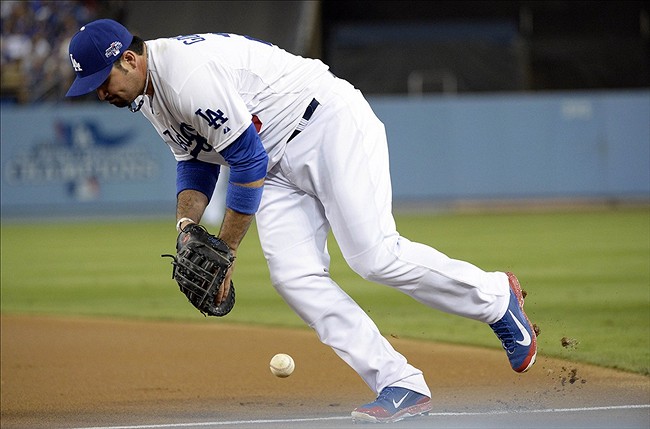Not every prospect makes it. Most never do. Most prospects don’t play above double-A ball. Some just get hurt and fade out of the spotlight. Not every prospect is going to be a super star like Corey Seager, or Cody Bellinger. Those guys are rare talents. So when the Dodgers announced today that young left handed starting pitcher Julio Urias needed shoulder surgery it was not only not surprising, but supremely depressing. What the Dodgers have been petrified of happening has actually happened. Urias is out indefinitely.
The news is actually far worse than any of us could have imagined. Not only will Urias need surgery to repair an anterior capsule, he’ll be sidelined for 12-14 months. This is a huge blow to the future plans of the Dodger pitching staff. Did the Dodgers ruin him by not allowing him to pitch on a normal schedule?
When the Dodgers originally decided to limit his innings, they had put a hard cap on him. No more than X amount of innings total they would say. Best laid plans of mice and men of course. Urias did exceed those limits last season, but not by much.
This season the Dodgers decided that they wanted to treat him with kid gloves and extra baby him. They announced that they would be leaving him in extended spring training. Once the major leaguers broke camp to fly to Los Angeles, Urias would remain in Glendale. I’m not sure exactly what he did there, but I know he wasn’t pitching in real games.
Whether he was sitting around, or throwing bullpen sessions, or throwing simulated games, he wasn’t allowed to actually pitch in real live games until he was optioned to triple-A Oklahoma City several weeks later. He did finally join the Dodgers later in the season because of injuries to the major league staff, but he didn’t pitch long before he was sent back down to Oklahoma City.
Urias made only five starts at the MLB level and posted an ERA of 5.21 while struggling with this command. Urias walked 14 and struck out only 11 in 23.2 innings pitched. In 6 starts at Oklahoma City, Urias posted a 2.59 ERA. He tossed 31.1 innings, but also had trouble with command down there as well.
Andrew Friedman stated that Urias suffered the injury on one pitch (calling it an “acute” injury), and not because of overwork. I don’t know if that is true or not, but obviously the injury can’t be because of overwork. Urias only pitched a little over 54 frames in 2017 between the Dodgers and Oklahoma City. So did the lack of a consistent schedule contribute to this injury?
This further proves the fact that pitch counts, and innings limits are useless. A young pitcher can blow out his arm in one inning, let alone over the course of many seasons. I think the lesson learned from this is that the Dodgers and other MLB clubs should allow their young hurlers to throw on a set schedule. That doesn’t mean you allow them to throw 300 innings, but you can monitor their workload while allowing them to develop via a normal throwing program.
I’m not saying this is the fault of Dodger management. But I think having him on a set throwing schedule instead of sitting him, then sending him up and down would have probably benefited him more than not. Get well soon Julio.





Could this be more inane?
Care to elaborate?
What is the point of the article? It’s hard to discern, but even more problematic are the meanderings you go through to not make a point.
As best I can tell, there are three building blocks before you get to what seems to be a medical conclusion (that having him on a set throwing schedule would have probably benefited him more than not.)
1. First there’s the title: “could the injury have been prevented.” Which is almost certainly yes (by not having him pitch at all), but in any practical sense no.
2. Then there’s this doozy of a conclusion that you glide into and then leave sitting there:
“That pitch counts, and innings limits are useless.” Are you the least bit aware of how moronic this is? Did you read Passan’s book? Have you looked at any history/precedents? This has been disproven about a thousand time. I’m not even sure you believe it, perhaps you just got caught up in writing?
3. Then you slink towards your conclusion with this doozy:
” I think the lesson learned from this is that the Dodgers and other MLB clubs should allow their young hurlers to throw on a set schedule. ” OK. I’ll bite. How did you (at the least) learn this? Did it take a few minutes of study? Is this conclusion just based on Urias’ injury? What does it imply too? What is a set schedule? Every fifth day? How’d that work out with Isringhausen? Pulsipher?
Fidrych?
But let’s stick with Urias. What I’d love is for you to explain how a set schedule would avoid this injury. Seriously, go ahead. Take as long as you want to research it. Take a week. I’m betting you can’t.
But if you add all these inane points together, you can squint and pound your head into what may be your thesis that you, Scott Andes fan and blog proprietor, actually know or believe you know how to best develop pitchers or avoid injury (again, I think with regular usage.)
If that is the point you are meandering towards, and if you don’t see the inanity in that, then I don’t know what to say.
Scott does make a point that is unsupportable: that pitch counts and innings limits are useless. It dovetails with his overarching thesis that this front office is perpetually mismanaging something or other. So, however Urias was handled was wrong and contributed to his injury.
You should have just pointed this out and left it at that, because I don’t think your follow up arguments are really compelling either.
I think the proclivity of pitchers to injure their arms and shoulders amid an era in baseball where there are innings limits and pitch counts is not evidence that this practice works. There are measurably more injuries today where starting pitchers are rare if they pitch 200 innings than a generation ago where starting pitchers pitched 300. I don’t think that was Passan’s point at all: that innings limits are effective at the major league level (he makes more of a point about overuse beginning in childhood when kids are steered towards specialization and year-round baseball)
And using the small sample size of Fidrych to make some point is just about as inane.
To Scott’s point, I work with athletes, and one of the ways I manage them is I measure and plot their workloads, over a longer time constant as well as a shorter one. The concept is to monitor and manage physical strain so it contributes in a controlled way to proper and predictable adaptation and better strength and fitness. Apply too much too soon and the athlete can’t adapt and breaks down, too little or applied sporadically and he doesn’t reach potential and doesn’t progress.
Scott can speculate that the on/off way of managing Urias and his workload could have contributed to a spike in acute strain that MAY have contributed to his injury. He could make at least an intuitively logical case for that. There’s really no way to know, however. You can reference Passan or Mark The Bird all day long, but you don’t know, either.
Fair enough, I could have responded better.
The “Point of the article” is simply to get people to talk about it, that is what ‘bloggers’ do, Ding-Dong. If you were looking for “Great Literature”, that’s around the corner and up the stairs, watch out for dust bunnies….
That happens without inane articles Jonah.
Bluto,
you take the internet far too seriously. I never stated that a set schedule would have 100% prevented the injury, only that it POSSIBLY could have prevented his injury. The up and down, the lack of a cohesive plan or throwing schedule this season might have been a poor idea for a 20-year old pitcher trying to build arm strength. If he is unable to throw 100 innings at any level, or if management is unwilling to allow him to do this then how is he supposed to prepare to make 30-35 starts per season at the MLB level? This is just based on common sense.
I don’t care about Passan’s book, but I can give you a recent example of pitch counts and innings limits meaning nothing in regards to a young pitcher suffering a major arm injury. Steven Strasburg. He blew out his arm during hist first season after tossing 60 or 70 innings in his first couple of seasons.
I think that you can still manage a young pitcher’s innings and pitch counts without interupting their weekly pitching schedules. Of course don’t let them throw 130 pitches in a game, but allow them to pitch every fifth day like a normal pitcher and just maybe you can avoid major injuries while building arm strength. Think of the Atlanta Braves pitching staffs of the 1990s. pitching every fifth day and throwing regular bullpen sessions in between may be the better way to develop a young pitcher’s workload. I think the up and down nature of Urias’s season probably didn’t help anything.
Again this is just my opinion. No I am not a coach or doctor, nor do I work in MLB or have I ever pitched. I run a blog and am certainly entitled to write my opinions, which is what we do over here. There really is no reason for you to get this upset over an article on a Dodger blog. Just saying here. Perspective please Bluto.
I’m not the least bit upset.
If I got upset over stupid things I wouldn’t be long for this earth.
A good part of your reply revolves around not being able to avoid arm injuries. So don’t put up a post asking if one can be.
My first thought when I heard the announcement was that the Dodgers knew all along that Urias had some kind of shoulder weakness and their ‘prevention’ strategy was based on this knowledge. So much care went into their explanations about his erratic scheduling than any other pitcher I can remember. Who is treated with such kid gloves? Doesn’t make a lot of sense to me.
MJ and Michael are secretly married. There is no way that for two unrelated people to irritate the other as much as they do. Unless, one is the felonious catcher from the other blog, he pisses everyone off.
Bluto, it’s a blog. Far more things have been said without study. And I think Scott is just saying what’s on the back of the minds of some. I’ve also had Jeff’s thought flash across my mind before as well.
I think what Scott is saying we just don’t know for sure what causes some pitchers to get hurt, so even best laid plans, don’t always work.
This was no one’s fault.
But I have read some of the things Scott has wrote about pitching, and I understand what he is saying.
He is saying since there is no book or plan, that is 100 percent that a pitcher won’t get hurt, he thinks we should just let our young pitchers pitch.
And he is not saying don’t have any restrictions, he is saying let them pitch, but use common sense, when you do this.
Thank You MJ, this is exactly what I was saying.
If my theory of,” there’s only so many pitches in an arm” holds any water, maybe he should have been promoted a long time ago. Now his time is up and it’s time for a rebuild. A lot of his picthes, probably most of them would have been very effective for the big league team. Too bad they were wasted in the minor leagues
Yeah. It doesn’t hold any water.
Several years ago we had an acronym, TINSTAAPP; it meant There is no such thing as a pitching prospect. It meant when a young pitcher got to the point of getting almost all the hitters out, it was time to bring him up to the majors, he really wasn’t going to learn anything more in the minors. I think that is true to some extent but I stop short of making it a law. The history of pitchers is that they build up to the point of being as good as they’re going to get, then they hold there awhile, then go down hill. Look how many pitchers in the majors that are locked in to long contracts that pay them ten times what they are now worth. If FAZ plans to use pitchers from our farm system (and acquired other ways) only to the point where somebody will give them a long contract for more than they are worth, then let them go and bring up new prospects, I have to agree with his philosophy, as long as there are no more Hills, Kazmirs, Andersons, etc. Perhaps your theory has merit, maybe number of good pitches is like lifespan, everyone is different and unpredictable.
Thank you for clarifying, you obviously get my point. A couple of years ago he was knocking them dead in the minor leagues, he could have been doing that for the Dodgers. All those great pitches were wasted in the minor leagues. Now it’s possible he’ll never make it to the Dodgers. It could even be that he was overdoing it in order to make the big league team.
Bluto hasn’t been around long enough to realize that all things are possible and you really can’t predict anything with certainty. Education SHOULD open your eyes, not put blinders on them.
Common sense can be some help too.
Ray
I agree we just don’t know, but if your a baseball team you want your best to throw most of their pitches preferably at the major league level, if a pitcher is ready for that competition at that level.
We haven’t heard much from you, since the Dodgers didn’t sign Blanton, but you must know what happened, with him.
To the question of this injury being avoided.
Maybe. Probably not. Urias has been a pro for 4 1/2 years. In that time he threw 298 minor league innings with 15-8 overall record, a 2.65 ERA and a 1.09 WHIP. He’s thrown 100 or so innings in the bigs. He’s 20. It was my contention he wasn’t supposed to be here this year. 4 1/2 years, only 399 total innings, I think that’s as gentle as you should need to be with young pitcher. I don’t know the minute details surrounding this injury but apparently it was meant to happen. I don’t believe any of his pitches were wasted in the minors. The Dodgers had 6 Major League starters signed and expected to go this year. There should not have been any reason to expect Urias to be a 7th. That changed quickly as the inevitable of course happened and the fans were asking for Urias.
The question I would ask is did the trainers and pitching coaches on the staff here and at OKC have any idea that something was going on with him? He was fine until the May 14th game against Colorado. . Then on May 21st he was rocked by the Marlins. I read a report dated 6-23 that said he had an MRI “last week” that showed no structural damage. The report on the 15th said he should be fine with a couple weeks rest. From those reports to surgery and out a year. He had pitched 17 innings, 3 starts, since his demotion. I think something happened in mid May and it wasn’t caught by staff.
Badger
I don’t know about your conclusion, but it is good to see you back!
He went looking for his pal, Freudy…
Freudy uninvited me from his site for asking who the other Badger is and also asking why a post I wrote disappeared. He claimed he didn’t know what I was talking about. Bullshit. Then he told me “life’s too short”. The guy who bitches and whines more than anybody lectures me. I’m done with Freudy. In fact, I’m kinda losing interest in the whole blog thing. Not as much talking baseball as there usta was.
MJ – I have seen very little critical analysis of what happened with Urias. Is there a reason why? Is there a reason why so many injuries are happening all over baseball? Is it happening more in the Dodgers organization? I see little addressing of this issue. Injury prevention. Somebody should figure it out
Really Badger? Why would he do that? Seems like you’re one of the few people who actually comment over there.
I was. And I defended him here. Not sure why he did it but his site is a ghost town so no great loss. I’m still curious who the guy is that took my handle, and why he did it, but, oh well.
McCullough has a nice write-up about it, and he and Pedro discuss it in greater length on their podcast.
If I remembered the fake email I used on Dodger Therapy, I’d offer it to you Badger. You can be Jungey.
You were his biggest booster, here. I don’t know why you were so enamored with his writing. I never thought his prose style was all that.
I commented on there once. It was respectfully critical of his points. It was immediately deleted. I came on here and described how it was deleted and, somehow, it magically reappeared.
Someone who, as you describe, bitches and whines that much has to be a fundamentally unhappy person. Best you’re over it. Life’s too short.
As an old schooler, and one not enamored with most of new management’s moves, I appreciated his take on things. He’s obviously had some education in writing skills. He makes his points with vivid perspicuity. But I have a real problem with random censorship. And as you know, I have a problem with those who practice specific censorship as well. It’s a tyrant who stifles opposing opinions.
As a married man, you should be used to that…
If you’re suggesting my wife stifles conversation you could not be more wrong. Free speech is encouraged and practiced in our house.
I would never accuse any woman of stifling conversation. I’m sure I won’t live long enough to see that…
I actually find it hilarious that the crusty old guy, who never writes and (to me) just writes knee jerk reactions (Hill is injured! The process that led to him was stupid! The Dodgers started slowly! The process that led to that was stupid!) goes so far out of his way to alienate the few people who write comments to his writing.
He never responded to my post, but went to town on accusing people of writing under different names, then on telling off Badger.
To quote the Simpsons:
Some of them act badly because they’ve had a hard life, or have been mistreated. But some of them are just jerks